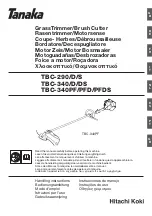
7
5. MAINTENANCE
(Ref. to Fig. 3)
Air in the hydraulic circuit may affect the performance of the tool; e.g: no advancement or slow
advancement of the lower blade; lower blade pulsating.
In this case proceed as follows:
5.1) To purge air bubbles from hydraulic circuit
a
– Hold tool upright in a vice with handles open (Fig. 3).
b
– Using a 2,5 mm allen key, remove screws (17 and 56) and relevant washers, slide off the fixed
handle (200) to expose the oil reservoir (03).
Recover spring (54) and spring cover (53).
c
– Remove reservoir cap (01).
d
– Operate the moveable handle (202) three or four times to advance the ram.
e
– Depress pressure release pin (65) until ram is fully retracted.
f
– Repeat points (
d
-
e
) at least five times, to ensure all air bubbles in the hydraulic circuit are purge
into the reservoir.
g
– If the oil level is low, top up as directed in §
5.2
.
h
– Remove all air from reservoir and fit cap (01).
i
– With the tool in the horizontal position, relocate spring (54) and spring cover (53) in seat A (see
detail in Fig. 3).
Reassemble the fixed handle, insert screws (17 and 56) complete with washers in their respective
positions and tighten them.
If the tool continues to malfunction return the tool for service/repair as detailed in §
2
.
5.2) Oil top up
Every six months check the oil level in the reservoir. If necessary, top up the oil level to the top lip
of the reservoir and remove all air from reservoir, see §
4.1
, points
a
,
b
,
c
,
e
,
g
,
h
and
i
.
Always use clean recommended oil, see § 1.
Do not use old or recycled oil.
Do not use hydraulic brake fluid.
Ensure that disposal of used oil is in accordance with current legislation.
ENGLISH








































